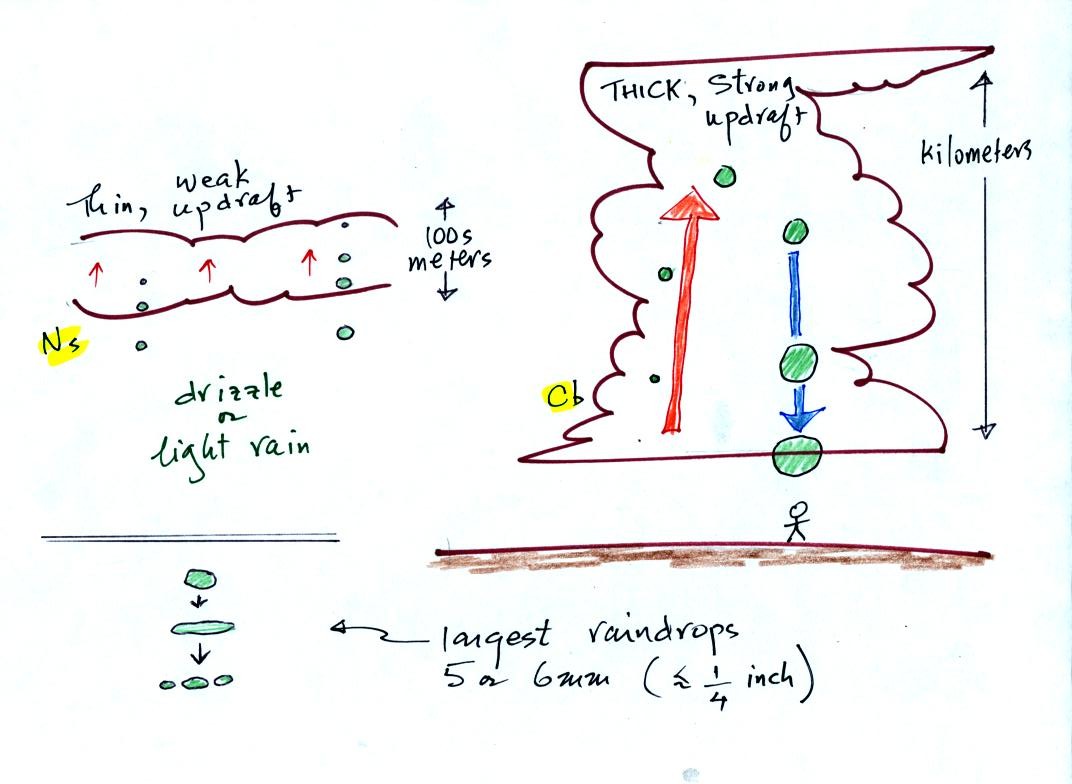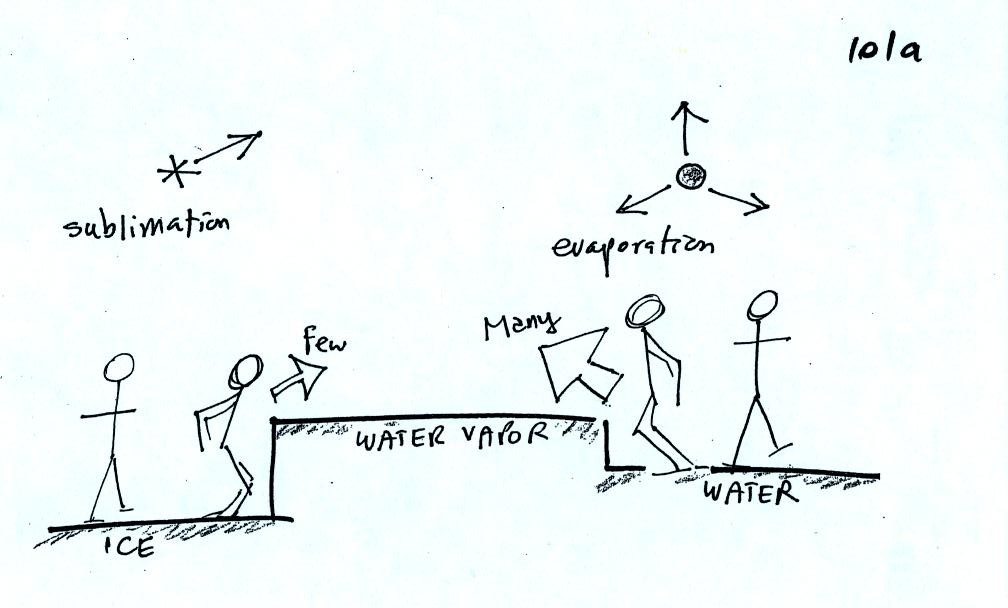Friday Oct. 26, 2007
The Experiment #4 materials were
distributed today. A limited number of sets of materials will be
available again next week.
The Experiment #3 reports and the revised
Expt. #2 reports are due on Monday (Oct. 29).
A variety
of question were asked during class. Answers to these questions
constituted an inclass Optional Assignment. You will find the question
(numbered 1-10) sprinkled throughout the class notes.
We didn't
have quite enough time in class on Wednesday to get started on the next
topic: formation of
precipitation. It is not as easy to make precipitation as you
might think. Only nimbostratus and cumulonimbus clouds are able
to do it.

This figure shows typical sizes of cloud
condensation nuclei (CCN), cloud droplets, and raindrops (a human hair
is about 50 um thick for comparison). As we
saw in the cloud in a bottle demonstration it is relatively easy to
make cloud droplets. You cool moist air to the dew point and
raise the RH to 100%. Water vapor
condenses pretty much instantaneously onto a cloud condensation nucleus
to form a cloud droplet. It
would take much longer (a day or more) for condensation to turn a cloud
droplet
into a
raindrop. You know from personal experience that once a cloud
forms you don't have to wait that long for precipitation to begin to
fall.
Part of the problem is that it takes quite a few 20 um diameter cloud
droplets to make one 2000 um diameter raindrop. How many
exactly? The raindrop is 100 times bigger across. Volume is
three dimensions. The raindrop is 100 times wider, 100 times
deeper, and 100 times higher than the cloud droplet. The raindrop
has a volume that is 100 x 100 x 100 times larger than the volume of
the cloud droplets. Question
1a: What is 100 x 100 x 100? Question 1b: What is the volume
of a sphere?

Fortunately there are two processes capable of quickly
turning small cloud droplets
into much larger precipitation particles in a cloud.

The collision coalescence process works in clouds that are
composed of water droplets only. Clouds like this are only found
in
the tropics. We'll see that this is a pretty easy process to
understand. This process will only produce rain.
The ice crystal process produces precipitation everywhere else.
This is the process that makes rain in
Tucson, even in the hottest part of the summer. There is one part
of this process that is a little harder to understand. Though
this process can produce a variety of different kinds of precipitation
(rain, snow, hail, etc).
Question 2: What are the
names of the two cloud types capable of producing significant amounts
of precipitation?
Here's
what you might see if you looked inside a warm cloud with just water
droplets:

The collision coalescence process works best in a cloud
filled with cloud droplets of different sizes. As we saw in a
short video the larger droplets fall
faster than the small droplets. A larger than average cloud
droplet will overtake and collide with smaller slower moving
ones.

This is an acclerating growth process. The falling droplet gets
wider, falls faster, and sweeps out an increasingly larger volume
inside the cloud.

The figure below shows the two precipitation producing clouds:
nimbostratus (Ns) and cumulonimbus (Cb). Ns clouds are thinner
and have weaker updrafts than Cb clouds. Cb clouds are thicker
and have much stronger updrafts. The largest raindrops
fall from Cb clouds because the droplets spend more time in the cloud
growing.

Raindrops grow up to about 1/4 inch in diameter. When
drops get
larger than that, wind resistance flattens out the drop as it falls
toward the ground. The drop begins to "flop" around and breaks
apart
into several smaller droplets. Solid precipitation particles such
as hail can get much larger than 1/4 inch in diameter.
Question 3: How many 200 um
diameter drizzle drops would you need to make one 2000 um diameter
raindrop?
Before
learning about the second precipitation producing process, the ice
crystal process, we need to look at the structure of cold clouds.

The bottom of the thunderstorm, Point 1, is warm enough
(warmer than freezing) to just
contain water
droplets. The top of the thunderstorm, Point 2, is colder than
-40 C and just contains ice crystals. The interesting part of the
thunderstorm and the
nimbostratus cloud is the middle part, Point 3, that contains both
supercooled water
droplets (water that has
been cooled to below freezing but hasn't frozen) and ice
crystals.
This is called the mixed phase
region. This is where the ice crystal process will be able
to produce
precipitation. This is also where the electrical charge that
results in lightning is generated.
The supercooled water droplets aren't able to freeze even though
they
have been cooled below freezing. At Point 4 we see this is
because it is much
easier for small droplets of water to freeze onto an ice crystal
nucleus (just like it is easier for water vapor to condense onto
condensation nuclei rather than condensing and forming a small droplet
of pure water). Not just any material will work as an ice nucleus
however. The material must have
a crystalline structure that is like that of ice.
Question 4a: What is the
flat top of a thunderstorm called?
Queston 4b: What is the
lumpy cloud feature on the bottom side of the flat top called?
Question 6: High altitude
clouds are composed entirely of __________.
Question 5: Which process CC or
IC produces rain in the summer in Tucson?
We'll see next how the ice crystal process works. There's a
couple of tricky parts.

The first figure above (see p.101 in the photocopied Class Notes)
shows a water droplet in equilibrium with its surroundings..The droplet
is evaporating (the 3 green arrows in the figure). The rate of
evaporation will depend on the temperature of the water droplet.
The droplet is surrounded by air that is saturated with water vapor
(the droplet is inside a cloud where the relative humidity is
100%). This means there is enough water vapor to be able to
supply 3 arrows of condensation.
The next figure shows what is required for an ice crystal (at the same
temperature) to be in equilibrium with its surroundings. First
the ice crystal won't evaporate as rapidly as the water droplet (only
one arrow is shown). Going from ice to water vapor is a bigger
jump than going from water to water vapor. There won't be as many
ice molecules with enough energy to make that jump. A sort of
analogous situation is shown in the figure below (many people could
jump up a 1 foot step, fewer people would be able to jump up a 3 foot
step).
To be in equilibrium only one arrow of condensation is needed.
There doesn't need to be as much water vapor in the air surrounding the
ice crystal to supply this lower rate of condensation.

There are going to be fewer people able to make the big jump on the
left just as there are fewer ice molecules able to sublimated.
Going from water to water vapor is a "smaller jump" and more molecules
are able to do just as more people would be able to make the shorter
jump at right in the picture above.
Now what happens in the mixed phase region of a cold cloud
is that
ice crystals find themselves in the very moist surroundings needed for
water droplet equilibrium. This is shown below.

The water droplet is in equilibrium (3 arrows of evaporation
and 3
arrows of condensation) with the surroundings. The ice crystal is
evaporating more slowly than the water droplet. Because the ice
crystal is in the same surroundings as the water droplet water vapor
will be condensing onto the ice crystal at the same rate as onto the
water droplet. The ice crystal isn't in equilibrium, condensation
exceeds evaporation and the ice crystal will grow.
Question 7: Are
water droplets and ice crystals are found together in clouds at
temperatures ABOVE (warmer than) or BELOW (colder
than) freezing?
The equal rates of condensation are shown in the figure below using the
earlier analogy.

We'll look
at the variety of things that can happen to a growing ice crystal in a
cold cloud in class on Monday.
Question 8: Do water
droplets and ice crystals found together at the same temperature in a
cloud evaporate at the SAME or at DIFFERENT rates?
Question 9: Ice crystals
don't actually evaporate. What is the name of the solid to gas
phase change?
Question 10: (changed
slightly from the one given in class): Should 1, 2, or 3 arrows of
condensation be drawn going to the ice crystal in the figure below?













